The Mormon Trail of Tears
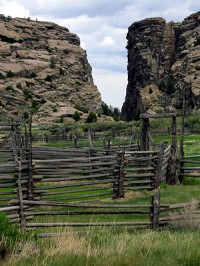 This was a rut I was grateful to be stuck in one crisp, blue-sky morning in eastern Wyoming. Standing deep in a trough on a sparsely wooded hill overlooking the North Platte River near the outskirts of Guernsey, I felt the earth rumble as oxen mooed, whips cracked, and covered wagons creaked up the steep rutted incline hauling heavy loads of the essentials, and the trivial. Hardened women in bonnets and long skirts followed coughing in the dust, and men in hats on horses yelled at their livestock and encouraged children and the old staggering to keep pace.
Among this rolling wave of humanity were hundreds of poor English and Scandinavian Mormons on foot who had no idea what awaited them in October of 1856 as they pushed and pulled two-wheeled carts with bloody hands ever-onward to Zion and the Valley of the Salt Lake for 1,300 tiresome miles in the ultimate test of their faith.
This was a rut I was grateful to be stuck in one crisp, blue-sky morning in eastern Wyoming. Standing deep in a trough on a sparsely wooded hill overlooking the North Platte River near the outskirts of Guernsey, I felt the earth rumble as oxen mooed, whips cracked, and covered wagons creaked up the steep rutted incline hauling heavy loads of the essentials, and the trivial. Hardened women in bonnets and long skirts followed coughing in the dust, and men in hats on horses yelled at their livestock and encouraged children and the old staggering to keep pace.
Among this rolling wave of humanity were hundreds of poor English and Scandinavian Mormons on foot who had no idea what awaited them in October of 1856 as they pushed and pulled two-wheeled carts with bloody hands ever-onward to Zion and the Valley of the Salt Lake for 1,300 tiresome miles in the ultimate test of their faith.
- Friday, March 2, 2012

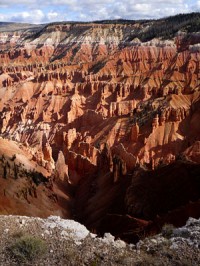 Heralded as one of the great natural amphitheaters of the world, Cedar Breaks will take your breath away not simply because of its eroded beauty and exceptional panoramic views, but also because it sits on top of a mountain on the edge of the Markagunt Plateau at 10,300 feet above sea level where clean air is paper thin and often blows very hard and steady like it did when we visited one recent golden autumn. Bobbing and weaving, while my beleaguered heart rumbled in my chest, I leaned into the wind, gasped for air and stood in amazement at Point Supreme and the Sunset View Overlook, two places you don't want to be during a July lightning storm.
The sheer size caught me off guard the first time I inched toward the edge where the land falls away abruptly exposing terrain shaped like the folds of a curtain, plunging chutes and exposed ridges and rocky forests of freestanding buttes and fin walls, stone arches and the hoodoo army which quite frankly reminds me of Bryce Canyon; everything painted pink and orange, and shades of purple. It's a slow, methodical process focusing on individual pieces that make up the whole, assimilating the mosaic and assigning it a proper place in your mind.
Heralded as one of the great natural amphitheaters of the world, Cedar Breaks will take your breath away not simply because of its eroded beauty and exceptional panoramic views, but also because it sits on top of a mountain on the edge of the Markagunt Plateau at 10,300 feet above sea level where clean air is paper thin and often blows very hard and steady like it did when we visited one recent golden autumn. Bobbing and weaving, while my beleaguered heart rumbled in my chest, I leaned into the wind, gasped for air and stood in amazement at Point Supreme and the Sunset View Overlook, two places you don't want to be during a July lightning storm.
The sheer size caught me off guard the first time I inched toward the edge where the land falls away abruptly exposing terrain shaped like the folds of a curtain, plunging chutes and exposed ridges and rocky forests of freestanding buttes and fin walls, stone arches and the hoodoo army which quite frankly reminds me of Bryce Canyon; everything painted pink and orange, and shades of purple. It's a slow, methodical process focusing on individual pieces that make up the whole, assimilating the mosaic and assigning it a proper place in your mind.
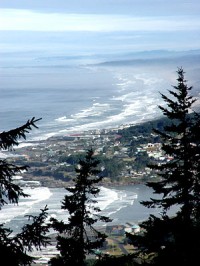 On a clear day the view from the headlands at the Sea Lions Cave visitors center is outstanding. But step too close to the edge and you'll get the woozies, maybe the wobblies, as you gaze down at fields of wavy green grass that plunge 300 feet to the blue Pacific churning and sloshing back-and-forth in a perpetual rolling ballet.
Look south to Florence eleven miles distant and watch the wide, empty beach recede into a misty horizon. Look north two miles and there, perched high on a bluff, is the beautiful Heceta Head Lighthouse, the most photographed and arguably most beautiful lighthouse on the Oregon Coast, though I'm not sure how that's measured. Then step in the elevator and plunge 208 feet down into the bowels of mother earth for the experience of a lifetime. Really. For a reasonable price of admission you'll be treated to the world's largest sea cave. It's not a gimmick or a circus trick, just nature hard at work carving out basalt rock one salty wave at a time. And yes, those are sea lions down there lounging about, rubbing blubber, yelping and multiplying, and stinking up the place.
On a clear day the view from the headlands at the Sea Lions Cave visitors center is outstanding. But step too close to the edge and you'll get the woozies, maybe the wobblies, as you gaze down at fields of wavy green grass that plunge 300 feet to the blue Pacific churning and sloshing back-and-forth in a perpetual rolling ballet.
Look south to Florence eleven miles distant and watch the wide, empty beach recede into a misty horizon. Look north two miles and there, perched high on a bluff, is the beautiful Heceta Head Lighthouse, the most photographed and arguably most beautiful lighthouse on the Oregon Coast, though I'm not sure how that's measured. Then step in the elevator and plunge 208 feet down into the bowels of mother earth for the experience of a lifetime. Really. For a reasonable price of admission you'll be treated to the world's largest sea cave. It's not a gimmick or a circus trick, just nature hard at work carving out basalt rock one salty wave at a time. And yes, those are sea lions down there lounging about, rubbing blubber, yelping and multiplying, and stinking up the place.
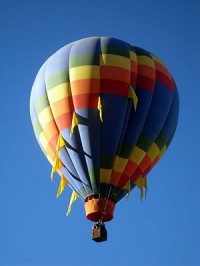 Saturated in the arts and a rich Hispano heritage, awash in charming adobe-style architecture and 400 years of contentious history marked by occasional bloodletting of incomprehensible proportions, this quaint Northern New Mexico resort community of international fame has been known to cast a spell, a benign trance that reels back seekers and others inclined to the aesthetic year after year. But beware. If you're not careful, even you might turn your back on urban life and move here like so many globetrotters and the creative who tap into the landscape's romantic inspiration that lends itself to their creativity and peace of mind.
Painters, potters, sculptors and writers the caliber of D.H. Lawrence and John Nichols have plied their craft on the verdant high desert of the Taos Plateau, and men and women, with and without talent, continue to aspire to the works of the hand alongside temperamental actors and rebounding directors at home among the eclectic and traditional. They're a special breed, perhaps, setting themselves apart and infusing a peculiar vitality into this ancient community of narrow crooked streets and buildings flat and square and rectangular, stacked low to the ground in clean lines of smooth plaster and mud colored in tranquil tones; the browns of the earth and deeper shades of red, and pink, and the lighter scales of blue.
Saturated in the arts and a rich Hispano heritage, awash in charming adobe-style architecture and 400 years of contentious history marked by occasional bloodletting of incomprehensible proportions, this quaint Northern New Mexico resort community of international fame has been known to cast a spell, a benign trance that reels back seekers and others inclined to the aesthetic year after year. But beware. If you're not careful, even you might turn your back on urban life and move here like so many globetrotters and the creative who tap into the landscape's romantic inspiration that lends itself to their creativity and peace of mind.
Painters, potters, sculptors and writers the caliber of D.H. Lawrence and John Nichols have plied their craft on the verdant high desert of the Taos Plateau, and men and women, with and without talent, continue to aspire to the works of the hand alongside temperamental actors and rebounding directors at home among the eclectic and traditional. They're a special breed, perhaps, setting themselves apart and infusing a peculiar vitality into this ancient community of narrow crooked streets and buildings flat and square and rectangular, stacked low to the ground in clean lines of smooth plaster and mud colored in tranquil tones; the browns of the earth and deeper shades of red, and pink, and the lighter scales of blue.
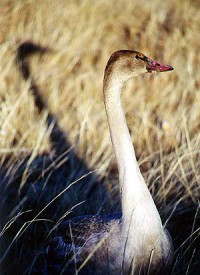 There I stood with my mouth open in disbelief on a small rise at the edge of rolling prairie near the southern end of Montana's Rocky Mountain Front. Catching my breath, I listened to loud rumbling as the earth quivered beneath the split hooves of mule deer in the hundreds thundering off in a bounding panic through twisted jack pine and brittle, tan grass and prickly pear. They ran for their lives, those beautiful mulies, through rolling foothills near towering cliffs at the entrance to the Sun River Canyon 20 miles west of Augusta - the greatest little cow town in the American West.
Suddenly it dawned on me. No wonder famed American novelist A.B. Guthrie lived on the Front near Choteau a few miles north of here. He could have lived anywhere, but settled for a slice of heaven on earth within sight of Ear Mountain. The same can be said for old what's-his-name who jets back to Montana between jokes and more recently sank roots in the shadow of this incredible, uplifted, 60-mile-long wall of mountains running north and south.
There I stood with my mouth open in disbelief on a small rise at the edge of rolling prairie near the southern end of Montana's Rocky Mountain Front. Catching my breath, I listened to loud rumbling as the earth quivered beneath the split hooves of mule deer in the hundreds thundering off in a bounding panic through twisted jack pine and brittle, tan grass and prickly pear. They ran for their lives, those beautiful mulies, through rolling foothills near towering cliffs at the entrance to the Sun River Canyon 20 miles west of Augusta - the greatest little cow town in the American West.
Suddenly it dawned on me. No wonder famed American novelist A.B. Guthrie lived on the Front near Choteau a few miles north of here. He could have lived anywhere, but settled for a slice of heaven on earth within sight of Ear Mountain. The same can be said for old what's-his-name who jets back to Montana between jokes and more recently sank roots in the shadow of this incredible, uplifted, 60-mile-long wall of mountains running north and south.
 Aside from remote stretches of sandy beach on South Padre Island, I can say without reservation that Big Bend is probably the best slice of outdoors this sprawling flat state has to offer. Cradled against a grand turn of the Rio Grande River, and sharing 118 desolate miles with Old Mexico crawling with dope smugglers and human coyotes, and wacko nut-jobs on both sides of the border laying low or on the lam, Big Bend National Park and the surrounding, inhospitable terrain elevates the wild and wooly, and the wonderful, to superlative extremes.
Harsh, prickly country unique and brash in that romantic Texas kind-of-a-way, I continue to dredge up fond memories of our autumn visit a few years ago; the solid image of a large, reddish-brown mountain lion, or cougar, sporting a long tail, gliding gently across the road on our drive down from the castle of jagged cliffs enveloping Chisos Basin. I also recall, rather vividly, getting trapped in a shoot as we scrambled into steep-walled Santa Elena Canyon while someone on the film-set down by the river's edge screamed in a blood-curdling tizzy, "Get the #@%* out of the way! We're trying to make a movie!"
Aside from remote stretches of sandy beach on South Padre Island, I can say without reservation that Big Bend is probably the best slice of outdoors this sprawling flat state has to offer. Cradled against a grand turn of the Rio Grande River, and sharing 118 desolate miles with Old Mexico crawling with dope smugglers and human coyotes, and wacko nut-jobs on both sides of the border laying low or on the lam, Big Bend National Park and the surrounding, inhospitable terrain elevates the wild and wooly, and the wonderful, to superlative extremes.
Harsh, prickly country unique and brash in that romantic Texas kind-of-a-way, I continue to dredge up fond memories of our autumn visit a few years ago; the solid image of a large, reddish-brown mountain lion, or cougar, sporting a long tail, gliding gently across the road on our drive down from the castle of jagged cliffs enveloping Chisos Basin. I also recall, rather vividly, getting trapped in a shoot as we scrambled into steep-walled Santa Elena Canyon while someone on the film-set down by the river's edge screamed in a blood-curdling tizzy, "Get the #@%* out of the way! We're trying to make a movie!"
 Things have never been the same after July 16, 1945 when they blew up the "gadget" on the northern fringes of the White Sands Missile Range in southern New Mexico, the largest military installation in the United States. Regrettably called the Trinity site, this historic landmark is where an atomic bomb perched atop a 100-foot tower made quite the splash as the first of its kind, casting radioactive fallout far and wide, most of which drifted north and east. But lingering radioactive contamination from that 200-yard-wide fireball that melted sand to glass was the least of my worries as I wandered dazed and delighted through the heart of 115-square-miles of rolling dunes within White Sands National Monument (WSNM), roughly 60 miles south of that exploding nuclear implosion.
I was more worried about going blind without my sunglasses, slogging among sugar-white, rippling hills of bone-dry snow, up one cone and down the other, or getting turned around out there and dying a lonely parched death by thirst among the vastness, swallowed up by a rolling ocean of bleached gypsum with camera in hand, clicking and snapping as I captured in digital bits and bytes the end of my life and the perennially shifting contours of this grainy surface of moon on earth.
Things have never been the same after July 16, 1945 when they blew up the "gadget" on the northern fringes of the White Sands Missile Range in southern New Mexico, the largest military installation in the United States. Regrettably called the Trinity site, this historic landmark is where an atomic bomb perched atop a 100-foot tower made quite the splash as the first of its kind, casting radioactive fallout far and wide, most of which drifted north and east. But lingering radioactive contamination from that 200-yard-wide fireball that melted sand to glass was the least of my worries as I wandered dazed and delighted through the heart of 115-square-miles of rolling dunes within White Sands National Monument (WSNM), roughly 60 miles south of that exploding nuclear implosion.
I was more worried about going blind without my sunglasses, slogging among sugar-white, rippling hills of bone-dry snow, up one cone and down the other, or getting turned around out there and dying a lonely parched death by thirst among the vastness, swallowed up by a rolling ocean of bleached gypsum with camera in hand, clicking and snapping as I captured in digital bits and bytes the end of my life and the perennially shifting contours of this grainy surface of moon on earth.
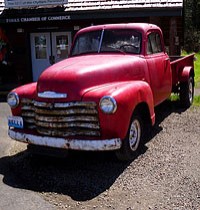 There was a time in my life when I thought the only contribution the little town of Forks in northwestern Washington made to civilization was rain, receiving over 100 inches of the dreary slop each and every year. That shows you what I knew, and how utterly unsophisticated I am because concealed in this old, middle-class logging town wedged between Olympic National Park to the southeast and 60 miles of wilderness beach a few miles west are handsome, albeit pasty-looking, blood-sucking vampires casting bedroom eyes at exposed necklines, breathing deep and working up ferocious appetites for things dripping, red and raw.
There was a time in my life when I thought the only contribution the little town of Forks in northwestern Washington made to civilization was rain, receiving over 100 inches of the dreary slop each and every year. That shows you what I knew, and how utterly unsophisticated I am because concealed in this old, middle-class logging town wedged between Olympic National Park to the southeast and 60 miles of wilderness beach a few miles west are handsome, albeit pasty-looking, blood-sucking vampires casting bedroom eyes at exposed necklines, breathing deep and working up ferocious appetites for things dripping, red and raw.
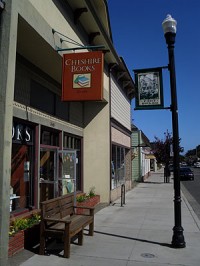 For years Hollywood has been enamored with Fort Bragg and the northern reaches of the quintessentially craggy Mendocino Coast. It's a great place to film. Parts of "One Flew Over the Cuckoo's Nest" (1975) with Jack Nicholson was filmed here, as was "Overboard" (1987) starring Goldie Hawn and Kurt Russell, and "The Majestic" (2001) with Jim Carrey. The 1966 hit "The Russians are Coming, The Russians are Coming," which seemed a lot funnier back then, was also filmed at Fort Bragg, Noyo Harbor, and quaint and beautiful Mendocino a few miles down the road.
Relative isolation helped protect this beautiful stretch of real estate from California's 40 million residents who would overrun this pristine old logging and fishing town three to four hours north of San Francisco if you gave them half a chance. It's not distance alone that shields the restored Victorian homes, gorgeous harbor and phenomenal sand beaches from the outside world, but coastal mountains as well, and maddening corkscrew roads that twist and turn and bend sharply through steep forested terrain once dense with towering redwoods now toppled and long gone for the most part.
For years Hollywood has been enamored with Fort Bragg and the northern reaches of the quintessentially craggy Mendocino Coast. It's a great place to film. Parts of "One Flew Over the Cuckoo's Nest" (1975) with Jack Nicholson was filmed here, as was "Overboard" (1987) starring Goldie Hawn and Kurt Russell, and "The Majestic" (2001) with Jim Carrey. The 1966 hit "The Russians are Coming, The Russians are Coming," which seemed a lot funnier back then, was also filmed at Fort Bragg, Noyo Harbor, and quaint and beautiful Mendocino a few miles down the road.
Relative isolation helped protect this beautiful stretch of real estate from California's 40 million residents who would overrun this pristine old logging and fishing town three to four hours north of San Francisco if you gave them half a chance. It's not distance alone that shields the restored Victorian homes, gorgeous harbor and phenomenal sand beaches from the outside world, but coastal mountains as well, and maddening corkscrew roads that twist and turn and bend sharply through steep forested terrain once dense with towering redwoods now toppled and long gone for the most part.
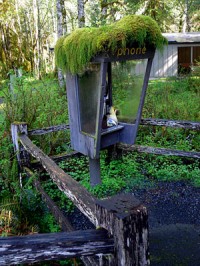 One languid week basking in the sun under stellar blue skies near the coast lulled me into a false sense of expectation, though I should have seen the clouds on the horizon. There's good reason why Olympic National Park on the Olympic Peninsula is lush and green in shades beyond comprehension. It rains too much, which is why this spectacular emerald gem thrives rich with huge, towering Douglas fir and ramrod-straight western hemlock and Sitka spruce.
Mercifully protected from the saw and ax, these trees are left to grow old, snapping and falling of their own accord over time onto rich black dirt, crushing tall ferns and massive globs of fluorescent green moss on their descent; toppling over as they were meant to, without our interference, with natural dignity, these wonderful old-growth giants as wide as a man is tall.
One languid week basking in the sun under stellar blue skies near the coast lulled me into a false sense of expectation, though I should have seen the clouds on the horizon. There's good reason why Olympic National Park on the Olympic Peninsula is lush and green in shades beyond comprehension. It rains too much, which is why this spectacular emerald gem thrives rich with huge, towering Douglas fir and ramrod-straight western hemlock and Sitka spruce.
Mercifully protected from the saw and ax, these trees are left to grow old, snapping and falling of their own accord over time onto rich black dirt, crushing tall ferns and massive globs of fluorescent green moss on their descent; toppling over as they were meant to, without our interference, with natural dignity, these wonderful old-growth giants as wide as a man is tall.
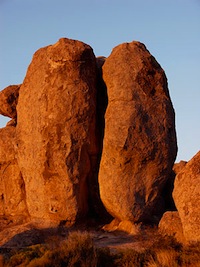 It's easy to write this place off as just another jumbled pile of boulders in the middle of nowhere until you appreciate the uniqueness of southwestern New Mexico's City of Rocks. Mind-altering and a photographer's delight, especially during the orange glow of early dawn, there are only 6 other places like this in the world.
Located halfway between Deming and Silver City, out on the grassy plains of the Mimbres Valley along the northern edge of the Chihuahuan desert, this sprawling fantasy land of towering monoliths, sculpted spires, twisting alleys and side streets and hidden coves have sheltered prehistoric Indians, provided sanctuary for roaming Apaches on the warpath, and enticed Spanish conquistadors and explorers for centuries. More recently 50,000 visitors, allegedly, scramble through this playful maze each year that is guaranteed to make you feel young at heart no matter how old you really are.
It's easy to write this place off as just another jumbled pile of boulders in the middle of nowhere until you appreciate the uniqueness of southwestern New Mexico's City of Rocks. Mind-altering and a photographer's delight, especially during the orange glow of early dawn, there are only 6 other places like this in the world.
Located halfway between Deming and Silver City, out on the grassy plains of the Mimbres Valley along the northern edge of the Chihuahuan desert, this sprawling fantasy land of towering monoliths, sculpted spires, twisting alleys and side streets and hidden coves have sheltered prehistoric Indians, provided sanctuary for roaming Apaches on the warpath, and enticed Spanish conquistadors and explorers for centuries. More recently 50,000 visitors, allegedly, scramble through this playful maze each year that is guaranteed to make you feel young at heart no matter how old you really are.
 On August 9, 2002, while pursuing two members of a Mexican drug cartel who fled across the border from the land of severed heads and charred bodies into the United States with apparent ease, 28-year-old Ranger Kristopher Eggle was shot at Organ Pipe Cactus National Monument. One of the suspects opened fire with an AK-47 assault rifle striking Eggle below his protective vest, killing him.
His senseless death, and a host of other security-related problems that have plagued Organ Pipe over the years, prompted the National Park Rangers Lodge of the Fraternal Order of Police to designate Organ Pipe the most dangerous park (technically a national monument) in the nation. And what a pity that is.
On August 9, 2002, while pursuing two members of a Mexican drug cartel who fled across the border from the land of severed heads and charred bodies into the United States with apparent ease, 28-year-old Ranger Kristopher Eggle was shot at Organ Pipe Cactus National Monument. One of the suspects opened fire with an AK-47 assault rifle striking Eggle below his protective vest, killing him.
His senseless death, and a host of other security-related problems that have plagued Organ Pipe over the years, prompted the National Park Rangers Lodge of the Fraternal Order of Police to designate Organ Pipe the most dangerous park (technically a national monument) in the nation. And what a pity that is.
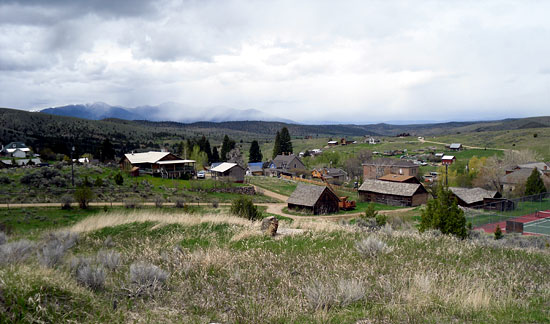
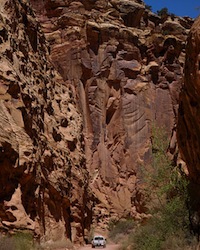 Among southern Utah's five magnificent national parks, Capitol Reef deserves special acclaim because it's less crowded, less commercial, holds bragging rights to red-rock scenery rivaling that of Arches, Bryce, Canyonlands or Zion, and in a day when admission fees are skyrocketing to preposterous levels, except for the official ten-mile "Scenic Drive" it's the only national park in southern Utah that's free, for the time being.
Rugged beyond belief and to its credit, remote, this 378-square-mile park is a long, narrow strip of stunning geology, a classic monocline, a 100-mile-long stepped-up wrinkle called the "Waterpocket Fold," or upthrust, that stretches from the Thousand Lake Plateau north of tiny Torrey, south to the still waters of the Colorado River known today as Lake Powell by most, and Lake Foul by those who continue to mourn Glen Canyon's senseless inundation.
Among southern Utah's five magnificent national parks, Capitol Reef deserves special acclaim because it's less crowded, less commercial, holds bragging rights to red-rock scenery rivaling that of Arches, Bryce, Canyonlands or Zion, and in a day when admission fees are skyrocketing to preposterous levels, except for the official ten-mile "Scenic Drive" it's the only national park in southern Utah that's free, for the time being.
Rugged beyond belief and to its credit, remote, this 378-square-mile park is a long, narrow strip of stunning geology, a classic monocline, a 100-mile-long stepped-up wrinkle called the "Waterpocket Fold," or upthrust, that stretches from the Thousand Lake Plateau north of tiny Torrey, south to the still waters of the Colorado River known today as Lake Powell by most, and Lake Foul by those who continue to mourn Glen Canyon's senseless inundation.
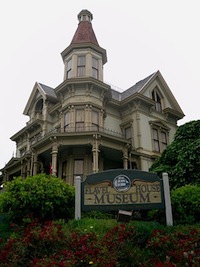 Standing near Fort Stevens looking out across the big blue Pacific on the extreme northwest corner of the Oregon Coast near Astoria where the mighty Columbia River empties into the sea I thought to myself: “No wonder the Japanese lost the war.” It was in the dark of night on June 12, 1942, when an Imperial submarine surfaced and lobbed 17 shells in the general vicinity of the fort before slinking off having inflicted no serious injury to speak of, their aim was that bad.
Things quieted down after that, for a while. The Fort Stevens I remember wasn't at war back in 1978. A hulking mass of abandoned concrete military bunkers out in the woods near the shore, it welcomed our unfettered exploration with not a soul in sight. Back then we camped at will and enjoyed miles of empty pristine beaches where me and my gal stripped and frolicked under a hot August sun in cold rolling waves, big ones, that roared ashore in foaming predictability.
Standing near Fort Stevens looking out across the big blue Pacific on the extreme northwest corner of the Oregon Coast near Astoria where the mighty Columbia River empties into the sea I thought to myself: “No wonder the Japanese lost the war.” It was in the dark of night on June 12, 1942, when an Imperial submarine surfaced and lobbed 17 shells in the general vicinity of the fort before slinking off having inflicted no serious injury to speak of, their aim was that bad.
Things quieted down after that, for a while. The Fort Stevens I remember wasn't at war back in 1978. A hulking mass of abandoned concrete military bunkers out in the woods near the shore, it welcomed our unfettered exploration with not a soul in sight. Back then we camped at will and enjoyed miles of empty pristine beaches where me and my gal stripped and frolicked under a hot August sun in cold rolling waves, big ones, that roared ashore in foaming predictability.
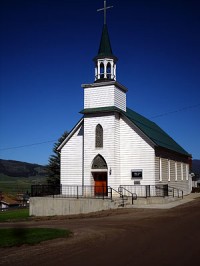 Nestled in the foothills on the edge of broad and spacious Flint Creek Valley, surrounded by mountains laden in past times with vast deposits of silver, manganese, sapphires, and to a lesser extent gold, beautiful historic Philipsburg is an anomaly because it's still standing. As one of twenty rowdy mining communities that once thrived within thirty miles of here only “P-burg” withstood the test of time. Battered and bruised and knocked down by devastating booms-and-busts endemic to that world of hard rock mining, Philipsburg kept getting up, dusted itself off and dug in for the long haul.
Granite, Tower, Rumsey, Black Pine and all the rest, home to thousands of scruffy men in those late 19th and early 20th century glory days, have vanished. Things quieted in their wake leaving us blank spots on a map or relics to ponder; crumbling foundations and rotting timbers and disintegrating piles of brick. These haunts of fanciful apparitions are a repository of story, gripping tales of hard-working men calloused inside and out, toiling twelve deadly hours each and every day, seven days a week under miserable conditions down there in the dark.
Nestled in the foothills on the edge of broad and spacious Flint Creek Valley, surrounded by mountains laden in past times with vast deposits of silver, manganese, sapphires, and to a lesser extent gold, beautiful historic Philipsburg is an anomaly because it's still standing. As one of twenty rowdy mining communities that once thrived within thirty miles of here only “P-burg” withstood the test of time. Battered and bruised and knocked down by devastating booms-and-busts endemic to that world of hard rock mining, Philipsburg kept getting up, dusted itself off and dug in for the long haul.
Granite, Tower, Rumsey, Black Pine and all the rest, home to thousands of scruffy men in those late 19th and early 20th century glory days, have vanished. Things quieted in their wake leaving us blank spots on a map or relics to ponder; crumbling foundations and rotting timbers and disintegrating piles of brick. These haunts of fanciful apparitions are a repository of story, gripping tales of hard-working men calloused inside and out, toiling twelve deadly hours each and every day, seven days a week under miserable conditions down there in the dark.
 I'd never heard of Abo, Gran Quivira or Quarai when we visited New Mexico during a recent blustery May, and I wasn't inclined to make that lonesome detour up the 55 to Estancia Basin that lies east and southish of the Manzano Mountains.
Dark green and low on the horizon, the Manzanos form a welcome barrier separating broad grassy plains the color of sand, and juniper-studded mesas, from Albuquerque's urban dysfunction.
Leaving Billy the Kid's Lincoln County in the side-view mirror, we barreled north toward those mountains and the Turquoise Trail, but as things go in this life of mine, I succumbed to a bad case of curiosity that flares up now and then like that itchy red rash I picked up off a toilet seat at the Lonesome Steer Grill and Swill outside Truth or Consequentials.
I'd never heard of Abo, Gran Quivira or Quarai when we visited New Mexico during a recent blustery May, and I wasn't inclined to make that lonesome detour up the 55 to Estancia Basin that lies east and southish of the Manzano Mountains.
Dark green and low on the horizon, the Manzanos form a welcome barrier separating broad grassy plains the color of sand, and juniper-studded mesas, from Albuquerque's urban dysfunction.
Leaving Billy the Kid's Lincoln County in the side-view mirror, we barreled north toward those mountains and the Turquoise Trail, but as things go in this life of mine, I succumbed to a bad case of curiosity that flares up now and then like that itchy red rash I picked up off a toilet seat at the Lonesome Steer Grill and Swill outside Truth or Consequentials.
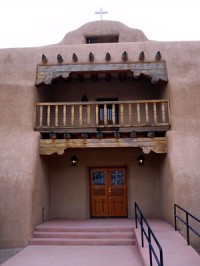 With few to equal her stature in the world of fine art, the late Georgia O'Keeffe (1887-1986) was one of America's preeminent painters, producing in seven long decades an astounding legacy of roughly 900 paintings that have captivated and inspired artists and connoisseurs the world over.
While she is remembered in large measure for her close-up, occasionally abstract, renderings of flowers - the lily, the hibiscus, the poppy - much of her inspiration was derived from the landscapes of her adopted home, north-central New Mexico; specifically that aesthetically rich terrain 60 miles northwest of Santa Fe known as "O'Keeffe Country."
Sandstone bluffs, layered and streaked, her beloved flat-topped Mt. Pedernal, adobe buildings and Spanish colonial churches, and doorways, trees and clouds, these were all source material for her unique vision.
With few to equal her stature in the world of fine art, the late Georgia O'Keeffe (1887-1986) was one of America's preeminent painters, producing in seven long decades an astounding legacy of roughly 900 paintings that have captivated and inspired artists and connoisseurs the world over.
While she is remembered in large measure for her close-up, occasionally abstract, renderings of flowers - the lily, the hibiscus, the poppy - much of her inspiration was derived from the landscapes of her adopted home, north-central New Mexico; specifically that aesthetically rich terrain 60 miles northwest of Santa Fe known as "O'Keeffe Country."
Sandstone bluffs, layered and streaked, her beloved flat-topped Mt. Pedernal, adobe buildings and Spanish colonial churches, and doorways, trees and clouds, these were all source material for her unique vision.
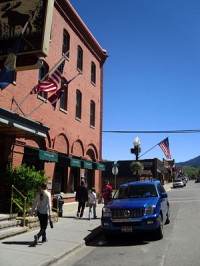 While America's famous journalist and travel correspondent Charles Kuralt called the Beartooth Highway "the most beautiful roadway in America," he might have overstated his case just a bit. Granted it's a judgment call, but for sheer beauty the Going-to-the-Sun Highway over Logan Pass in Glacier National Park leaves the Beartooth in the dust.
Never-the-less, the lofty Beartooth that rises to 10,947 feet and has been designated a National Scenic Byway can't be denied its place among aesthetic grandeur. The chorus of accolades are well-deserved because it is beautiful, it is marvelous and other-worldly. It's a thin-aired land of cropped tundra and green lichen among the clouds and lingering snowfields and rolling alpine grasses, and deep, deep canyons and sheer cliffs and tall mountains and roaring, sparkling rivers - away from it all.
While America's famous journalist and travel correspondent Charles Kuralt called the Beartooth Highway "the most beautiful roadway in America," he might have overstated his case just a bit. Granted it's a judgment call, but for sheer beauty the Going-to-the-Sun Highway over Logan Pass in Glacier National Park leaves the Beartooth in the dust.
Never-the-less, the lofty Beartooth that rises to 10,947 feet and has been designated a National Scenic Byway can't be denied its place among aesthetic grandeur. The chorus of accolades are well-deserved because it is beautiful, it is marvelous and other-worldly. It's a thin-aired land of cropped tundra and green lichen among the clouds and lingering snowfields and rolling alpine grasses, and deep, deep canyons and sheer cliffs and tall mountains and roaring, sparkling rivers - away from it all.
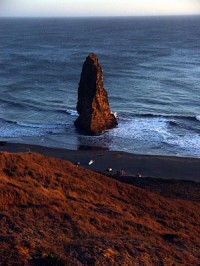 The mighty headland named Cape Blanco on the southern Oregon Coast is regarded by many Oregonians as the western-most land protrusion in the Lower-48. It certainly feels that way as one stands overwhelmed by the scenery on the very edge of the continent. The natural drama is palpable, sensual, ... potentially erotic.
It's a place where you can lean into the wind as it blows ashore under a broad canopy of clear blue sky whose seasonal colors shift from summer's deep blues to winter's dark-grays when sagging clouds verging on black roll overhead with the grace of titanic spaceships invading this water-logged state in rapid slow motion.
The mighty headland named Cape Blanco on the southern Oregon Coast is regarded by many Oregonians as the western-most land protrusion in the Lower-48. It certainly feels that way as one stands overwhelmed by the scenery on the very edge of the continent. The natural drama is palpable, sensual, ... potentially erotic.
It's a place where you can lean into the wind as it blows ashore under a broad canopy of clear blue sky whose seasonal colors shift from summer's deep blues to winter's dark-grays when sagging clouds verging on black roll overhead with the grace of titanic spaceships invading this water-logged state in rapid slow motion.